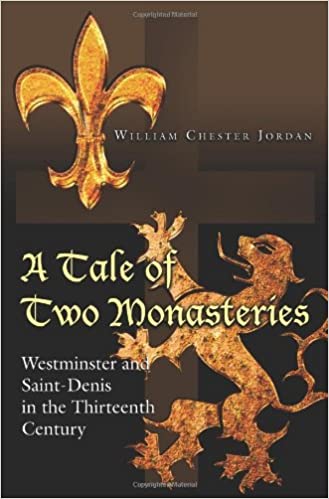Great abbeys such as Westminster and Saint-Denis were among the most organizationally complex and bureaucratically advanced entities operating below the level of the state in medieval Europe. As a consequence they have left historians with an immense array of sources from which to reconstruct their myriad activities. Thus, the title of this book is a bit misleading. Its twin subjects are not the abbeys of Westminster and Saint-Denis. The book chronicles the intertwined lives of two of their respective abbots, Richard de Ware (r. 1258-1283) and Mathieu de Vendôme (r.1258-1286).

William Chester Jordan thus made a wise decision in structuring his narrative around the lives of abbots instead of abbeys, for it allows him to tell a coherent story that remains accessible to the general reader without sacrificing scholarly rigor or historical detail.
Jordan chose the abbots of Westminster and Saint-Denis as his subjects because they led no ordinary abbeys. Both had secured papal exemptions from local ecclesiastical jurisdictions, which meant that they owed allegiance to Rome alone. Yet they also stood in close physical proximity to the seats of secular government, and enjoyed special relationships with their monarchs; as it is today, Westminster was then the coronation hall of English kings, while Saint-Denis served as the chief mausoleum for French monarchs. It fell to the abbots to maintain cordial relationships with the royal powers.
It is this explicitly political aspect of the abbots' duties that chiefly concerns Jordan. His first chapter summarizes the political struggles between England and France in the decades leading up to the election of the abbots, as the royal rivalry "provide[s] the essential introduction to the two abbots' history and that of their monasteries in their lifetimes (1)." With the exception of the fifth chapter, which focused on building projects at the abbeys, each successive chapter dwelt on phases in this political drama. As a result, readers learn more from this account about the political history of England and France than they do about monastic life, and as much about the parallel lives of Henry III of England and Louis IX of France as about those of Brothers Richard and Mathieu.
Readers could not ask for a better guide. Jordan has written widely on various subjects in medieval French history, and is perhaps the greatest living historian of the later Capetian monarchy. He has also published in English history, and throughout this book he demonstrates mastery of scholarship from both sides of the Channel. His footnotes reveal just how rare such competence is among medieval historians, as the names of scholars that frequently adorn the citations on Abbot Richard are almost never to be found in those on Abbot Mathieu. It is only in noting these bibliographical disparities that a reader begins to grasp Jordan's accomplishment. Jordan constructs a seamless political narrative which flits back and forth between Paris, London, Rome, and the Crusader States, and involves dozens of assorted political figures who worked with one another through an ever-shifting web of tenuous relationships. Only through many years of teaching, research, and writing on these subjects could Jordan make the construction of such an easy-to-read narrative seem so effortless. Newcomers to medieval history will find here an ideal introduction to thirteenth century politics, while more experienced students will learn much from Jordan's ever judicious commentary on sources and historiography.
Still, in the end two people suffer from all that talk of politics: the abbots themselves. By the close of the book, one gets the impression that Richard and Mathieu should be remembered chiefly as high-level government functionaries whose lives were inextricably tied to the fate of the nascent states they served.
Without question, the two men performed tremendous public services to their monarchs, but Jordan's focus on this subject to the detriment of other facets of abbatial life seems peculiar in light of earlier scholarly investigations of the subject, which tend to view the abbey rather than the royal personality as the primary organizational principal in the abbot's life. And while a paucity of sources often precludes the study of the private lives of public figures during the Middle Ages, there is no such lack for these two men. Indeed, perhaps the most detailed study of the day-to-day lives of monks yet written was based almost entirely on sources from Westminster Abbey.1
While Jordan provides imaginative and plausible reconstructions of the early lives of the two men in the second chapter, once they begin service to their monarchs, other aspects of their lives fall away. Occasionally Jordan will open up a line of analysis that draws some aspect of the abbots' roles in the monasteries into sharper focus, such as his original and fascinating argument that Mathieu reformed the record-keeping practices of St Denis early in his abbacy (67-70); yet just as this argument begins to develop traction, he backs off to return to the master political narrative, in this case Louis IX's reform movements.
In the final analysis, while this book is not quite what it set out to become, it is a thought-provoking work. Too often historians have viewed the great abbeys and abbots of the Middle Ages as virtually autonomous entities. Jordan has not only placed their activities squarely within the framework of the state, but has shown them to be integral to its development.
1 Barbara Harvey, Living and Dying in England: The Monastic Experience, 1100-1540, (Oxford: Clarendon Press, 1993).
